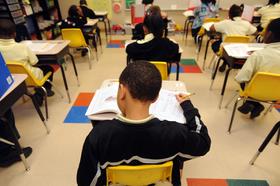Top Rankings
Washington Comm School District ranks among the top 20% of public school district in Iowa for:
Category
Attribute
Diversity
Most diverse schools (Top 1%)
Community Size
Largest student body (number of students) (Top 1%)
For the 2025 school year, there are 3 public elementary schools serving 1,186 students in Washington Comm School District. This district's average elementary testing ranking is 1/10, which is in the bottom 50% of public elementary schools in Iowa.
Public Elementary Schools in Washington Comm School District have an average math proficiency score of 62% (versus the Iowa public elementary school average of 70%), and reading proficiency score of 58% (versus the 69% statewide average).
Minority enrollment is 29% of the student body (majority Hispanic), which is equal to the Iowa public elementary school average of 29% (majority Hispanic).
Overview
This School District
This State (IA)
# Schools
4 Schools
924 Schools
# Students
1,621 Students
320,020 Students
# Teachers
119 Teachers
23,100 Teachers
Student-Teacher Ratio
14:1
14:1
Student By Grade
District Rank
Washington Comm School District, which is ranked within the bottom 50% of all 325 school districts in Iowa (based off of combined math and reading proficiency testing data) for the 2022-2023 school year.
The school district's graduation rate of 82% has decreased from 85-89% over five school years.
Overall District Rank
#298 out of 327 school districts
(Bottom 50%)
(Bottom 50%)
Math Test Scores (% Proficient)
61%
68%
Reading/Language Arts Test Scores (% Proficient)
59%
70%
Science Test Scores (% Proficient)
58%
63%
Graduation Rate
82%
90%
Students by Ethnicity:
Diversity Score
0.45
0.47
% American Indian
n/a
n/a
% Asian
1%
3%
% Hispanic
23%
13%
% Black
1%
7%
% White
71%
71%
% Hawaiian
n/a
1%
% Two or more races
4%
5%
All Ethnic Groups
District Revenue and Spending
The revenue/student of $16,819 is higher than the state median of $16,468. The school district revenue/student has stayed relatively flat over four school years.
The school district's spending/student of $15,566 is less than the state median of $16,042. The school district spending/student has stayed relatively flat over four school years.
Total Revenue
$27 MM
$8,262 MM
Spending
$25 MM
$8,048 MM
Revenue / Student
$16,819
$16,468
Spending / Student
$15,566
$16,042
Best Washington Comm School District Public Elementary Schools (2025)
School
(Math and Reading Proficiency)
(Math and Reading Proficiency)
Location
Quick Facts
Rank: #11.
Lincoln Upper Elementary School
(Math: 69% | Reading: 56%)
Rank:
Rank:
3/
Bottom 50%10
606 S 4th Ave
Washington, IA 52353
(319) 653-3691
Washington, IA 52353
(319) 653-3691
Gr: 3-5 | 344 students Student-teacher ratio: 12:1 Minority enrollment: 31%
Rank: #22.
Washington Middle School
(Math: 55% | Reading: 60%)
Rank:
Rank:
2/
Bottom 50%10
313 S. 4th Ave.
Washington, IA 52353
(319) 653-5414
Washington, IA 52353
(319) 653-5414
Gr: 6-8 | 349 students Student-teacher ratio: 11:1 Minority enrollment: 30%
Rank: n/an/a
821 N 4th Ave
Washington, IA 52353
(319) 653-3244
Washington, IA 52353
(319) 653-3244
Gr: PK-2 | 493 students Student-teacher ratio: 15:1 Minority enrollment: 27%
Recent Articles

Why Single-Sex Public Schools are Growing in Popularity
This article examines the growing trend of single-sex public schools in the United States. It explores the potential benefits, research findings, and controversies surrounding gender-specific education, as well as the factors driving its increasing popularity among parents and educators.

When Teachers Cheat: The Standardized Test Controversies
Teachers across the country are being accused of cheating on standardized tests, using erasers to conveniently change their students’ answers. However, are these teachers driven to cheat because the funding system is flawed?

When Field Trips Turn Deadly: Who is Responsible?
Recent deaths during field trips have parents and school officials questioning the safety of these excursions. Learn about these tragedies and what parameters should be in place to ensure a safe field trip.





